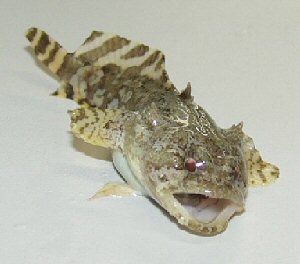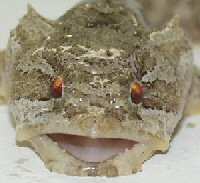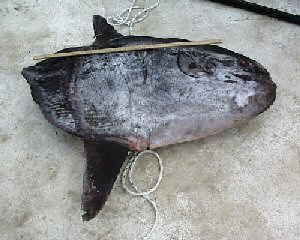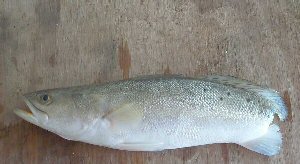Amazing Texas Fish
Dr. Barbara Gregg, TPWD Headquarters, Austin, Texas
You Just Won't Believe What I Saw . . . or Heard . . . or Caught!! How many times have you heard someone say that when they've been on a fishing trip on the Texas coast? You know that most of the time you are going to hear a whopper, but every once in a while you might get to see a picture of a very strange fish, crab, or shell, or you might be told a story of some very strange fish behavior.
For example, have you heard of a guitarfish? It's called a guitarfish (Rhinobatus lentiginosus - Greek word "rhinos" meaning nose and "batis", meaning a ray) because its shape is similar to a guitar or violin. They are also sometimes called shovelnose sharks, but they aren't sharks at all; guitarfish are rays. However, the guitarfish actually swims by moving its tail side to side like a shark, not a ray. In the Gulf, guitarfish remain small; although in the Pacific off California they may grow to 6 feet. In Texas, these fish reproduce using internal fertilization and give birth to as many as 6 live young. The young are born fully developed and about 8 inches long. They aren't considered harmful to humans and they're not really good to eat, however, catching one is very exciting and taking a picture of it makes a great punchline for your story.

Other fish also have unusual or misleading common names, like the Sea Robin (any of several species of Prionotus). Obviously, it is not a bird, but an ornate fish with hard bony head coverings, long spines, large pectoral fins, and short bodies. When the sea robin swims, it spreads its long pectoral fins and almost appears to walk or fly along the sea bottom, thus the bird name. In fact, the sea robin (found on the East coast all the way through the Gulf) is actually closely related to other flying fish found around the world.

A lot of unusual fish are named after other animals. The Gulf toadfish (Opsanus beta) is among several species that are well camouflaged for rocky estuary or bay bottoms. If you ever see or catch a Gulf toadfish, your first response may be "UGLY FISH!", however it isn't venomous, just ugly. In addition to its strange appearance, the toadfish is one of just a few fish which can make sounds loud enough for people to hear.

Strangely enough, it can also survive very stressful conditions like wide ranges in salinity or high levels of ammonia. That, plus the fact that it can often be obtained as unwanted bycatch from commercial shrimpers, make it a widely sought-after research species in marine laboratories.

The bigmouth goby (Gobiomorus dormitor) also known as the bigmouth sleeper is another bottom-dwelling camouflaged fish that is found off the southern Texas coast. As you can see from the picture, it deserves its common-name "bigmouth". Brownsville's Coastal Fisheries biologists, as well as anglers, often see these fish in Texas' more tropical waters.
Another fish occasionally found in southern Gulf waters is the sharptail Mola (Mola lancelata) or ocean sunfish. This very strange-looking fish bears no resemblance to a freshwater sunfish and in fact, hardly looks like a fish at all. It appears to have no tail and generally when seen in its normal environment, the open waters of the Gulf, sometimes looks like an upright piece of floating debris. The mola in this picture was caught offshore and brought back to the biologists in Brownsville for identification, but small ones like this are sometimes seen in near shore waters. In open water, they may reach up to 7 feet in length.

In fact, anglers and biologists were truly surprised by another tailless fish brought in one day. It is actually a spotted seatrout (Cynoscion nebulosus) that displays a genetic mutation or developmental anomaly producing taillessness. Somehow this one survived to adulthood and may have even spawned.

Even more interesting than strange-looking fish, are some of the unusual behaviors of even very common fish. Did you know that male gafftopsail catfish (Bagre marinus) and hardhead catfish (Arius felis) both incubate their eggs in their mouths? Current knowledge indicates that the female catfish deposits between up to about 60 fairly large eggs and a few smaller non-fertile ones into a shallow depression in the estuaries where they are fertilized by males attracted to the nest-building activity. The eggs are sticky and females, with their thickened, spoon-shaped pelvic fin, pick up some of the fertilized eggs and offer them to the male. If he accepts, he retains them in his mouth for 30 or more days until they hatch and are large enough to survive outside the male's protection. During that time, the male doesn't eat at all, although he may receive some nourishment from the small non-fertile eggs. Quite a sacrifice for the males, but it really gives the small fish a better chance to survive to maturity.
Probably one of the reasons saltwater fishing continues to fascinate anglers old and new is the unusual fish that may be attached to any hook that is put in the water. The species mentioned here are a smattering of what is out there. Other weird fish to look for in Texas water include sea horses or pipefish (yes, sea horses), anchovies, Atlantic midshipman (venomous), Southern stargazer (mildly shocking), Shrimp eels (look like snakes), Lookdowns (very thin and strange looking), Ladyfish (tarpon's cousin), cutlassfish or ribbonfish (wicked teeth), puffers (puff-up when threatened and their toxin is now being used in painkiller research), various flatfish (some right-eyed like the southern flounder and some left-eyed). But these are species for another story.
© Copyright Texas Parks and Wildlife Department. No part of this work may be copied, reproduced, or translated in any form or medium without the prior written consent of Texas Parks Wildlife Department except where specifically noted. If you want to use these articles, see Site Policies.